octane NISSAN TITAN 2017 2.G Owners Manual
[x] Cancel search | Manufacturer: NISSAN, Model Year: 2017, Model line: TITAN, Model: NISSAN TITAN 2017 2.GPages: 671, PDF Size: 7.96 MB
Page 539 of 671
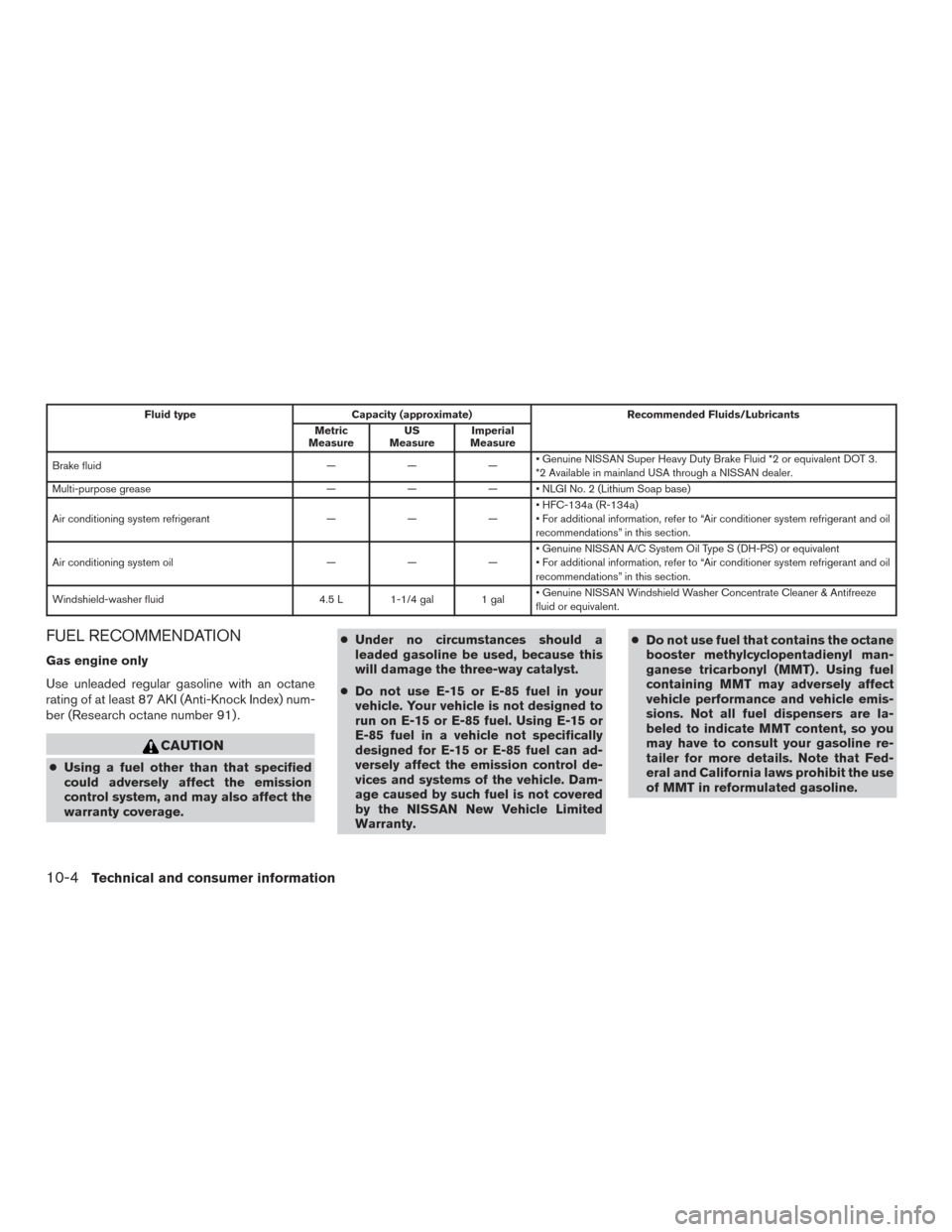
Fluid typeCapacity (approximate) Recommended Fluids/Lubricants
Metric
Measure US
Measure Imperial
Measure
Brake fluid ———• Genuine NISSAN Super Heavy Duty Brake Fluid *2 or equivalent DOT 3.
*2 Available in mainland USA through a NISSAN dealer.
Multi-purpose grease ——— • NLGI No. 2 (Lithium Soap base)
Air conditioning system refrigerant ———• HFC-134a (R-134a)
• For additional information, refer to “Air conditioner system refrigerant and oil
recommendations” in this section.
Air conditioning system oil ———• Genuine NISSAN A/C System Oil Type S (DH-PS) or equivalent
• For additional information, refer to “Air conditioner system refrigerant and oil
recommendations” in this section.
Windshield-washer fluid 4.5 L 1-1/4 gal 1 gal• Genuine NISSAN Windshield Washer Concentrate Cleaner & Antifreeze
fluid or equivalent.
FUEL RECOMMENDATION
Gas engine only
Use unleaded regular gasoline with an octane
rating of at least 87 AKI (Anti-Knock Index) num-
ber (Research octane number 91) .
CAUTION
●
Using a fuel other than that specified
could adversely affect the emission
control system, and may also affect the
warranty coverage. ●
Under no circumstances should a
leaded gasoline be used, because this
will damage the three-way catalyst.
● Do not use E-15 or E-85 fuel in your
vehicle. Your vehicle is not designed to
run on E-15 or E-85 fuel. Using E-15 or
E-85 fuel in a vehicle not specifically
designed for E-15 or E-85 fuel can ad-
versely affect the emission control de-
vices and systems of the vehicle. Dam-
age caused by such fuel is not covered
by the NISSAN New Vehicle Limited
Warranty. ●
Do not use fuel that contains the octane
booster methylcyclopentadienyl man-
ganese tricarbonyl (MMT) . Using fuel
containing MMT may adversely affect
vehicle performance and vehicle emis-
sions. Not all fuel dispensers are la-
beled to indicate MMT content, so you
may have to consult your gasoline re-
tailer for more details. Note that Fed-
eral and California laws prohibit the use
of MMT in reformulated gasoline.
10-4Technical and consumer information
Page 540 of 671
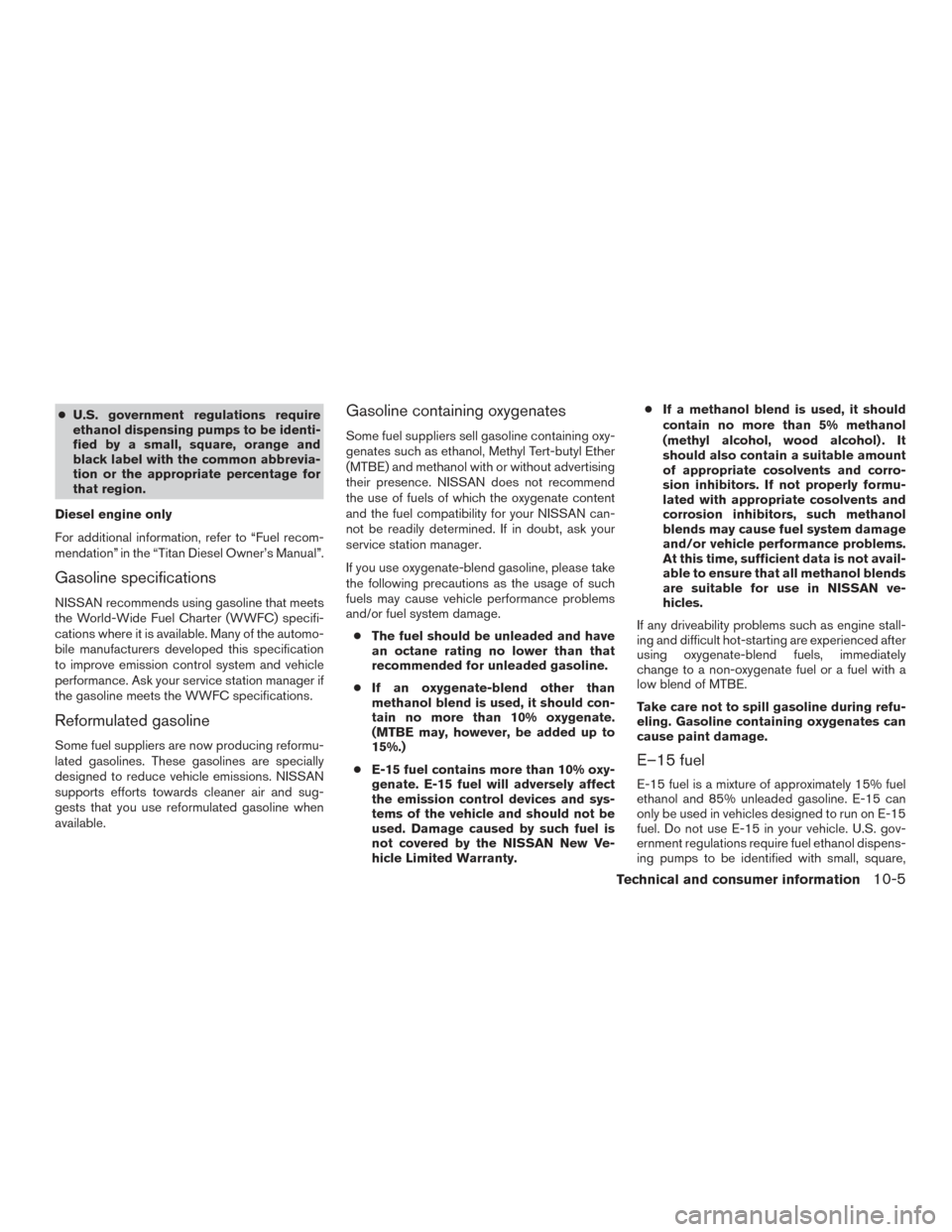
●U.S. government regulations require
ethanol dispensing pumps to be identi-
fied by a small, square, orange and
black label with the common abbrevia-
tion or the appropriate percentage for
that region.
Diesel engine only
For additional information, refer to “Fuel recom-
mendation” in the “Titan Diesel Owner’s Manual”.
Gasoline specifications
NISSAN recommends using gasoline that meets
the World-Wide Fuel Charter (WWFC) specifi-
cations where it is available. Many of the automo-
bile manufacturers developed this specification
to improve emission control system and vehicle
performance. Ask your service station manager if
the gasoline meets the WWFC specifications.
Reformulated gasoline
Some fuel suppliers are now producing reformu-
lated gasolines. These gasolines are specially
designed to reduce vehicle emissions. NISSAN
supports efforts towards cleaner air and sug-
gests that you use reformulated gasoline when
available.
Gasoline containing oxygenates
Some fuel suppliers sell gasoline containing oxy-
genates such as ethanol, Methyl Tert-butyl Ether
(MTBE) and methanol with or without advertising
their presence. NISSAN does not recommend
the use of fuels of which the oxygenate content
and the fuel compatibility for your NISSAN can-
not be readily determined. If in doubt, ask your
service station manager.
If you use oxygenate-blend gasoline, please take
the following precautions as the usage of such
fuels may cause vehicle performance problems
and/or fuel system damage. ● The fuel should be unleaded and have
an octane rating no lower than that
recommended for unleaded gasoline.
● If an oxygenate-blend other than
methanol blend is used, it should con-
tain no more than 10% oxygenate.
(MTBE may, however, be added up to
15%.)
● E-15 fuel contains more than 10% oxy-
genate. E-15 fuel will adversely affect
the emission control devices and sys-
tems of the vehicle and should not be
used. Damage caused by such fuel is
not covered by the NISSAN New Ve-
hicle Limited Warranty. ●
If a methanol blend is used, it should
contain no more than 5% methanol
(methyl alcohol, wood alcohol) . It
should also contain a suitable amount
of appropriate cosolvents and corro-
sion inhibitors. If not properly formu-
lated with appropriate cosolvents and
corrosion inhibitors, such methanol
blends may cause fuel system damage
and/or vehicle performance problems.
At this time, sufficient data is not avail-
able to ensure that all methanol blends
are suitable for use in NISSAN ve-
hicles.
If any driveability problems such as engine stall-
ing and difficult hot-starting are experienced after
using oxygenate-blend fuels, immediately
change to a non-oxygenate fuel or a fuel with a
low blend of MTBE.
Take care not to spill gasoline during refu-
eling. Gasoline containing oxygenates can
cause paint damage.
E–15 fuel
E-15 fuel is a mixture of approximately 15% fuel
ethanol and 85% unleaded gasoline. E-15 can
only be used in vehicles designed to run on E-15
fuel. Do not use E-15 in your vehicle. U.S. gov-
ernment regulations require fuel ethanol dispens-
ing pumps to be identified with small, square,
Technical and consumer information10-5
Page 541 of 671
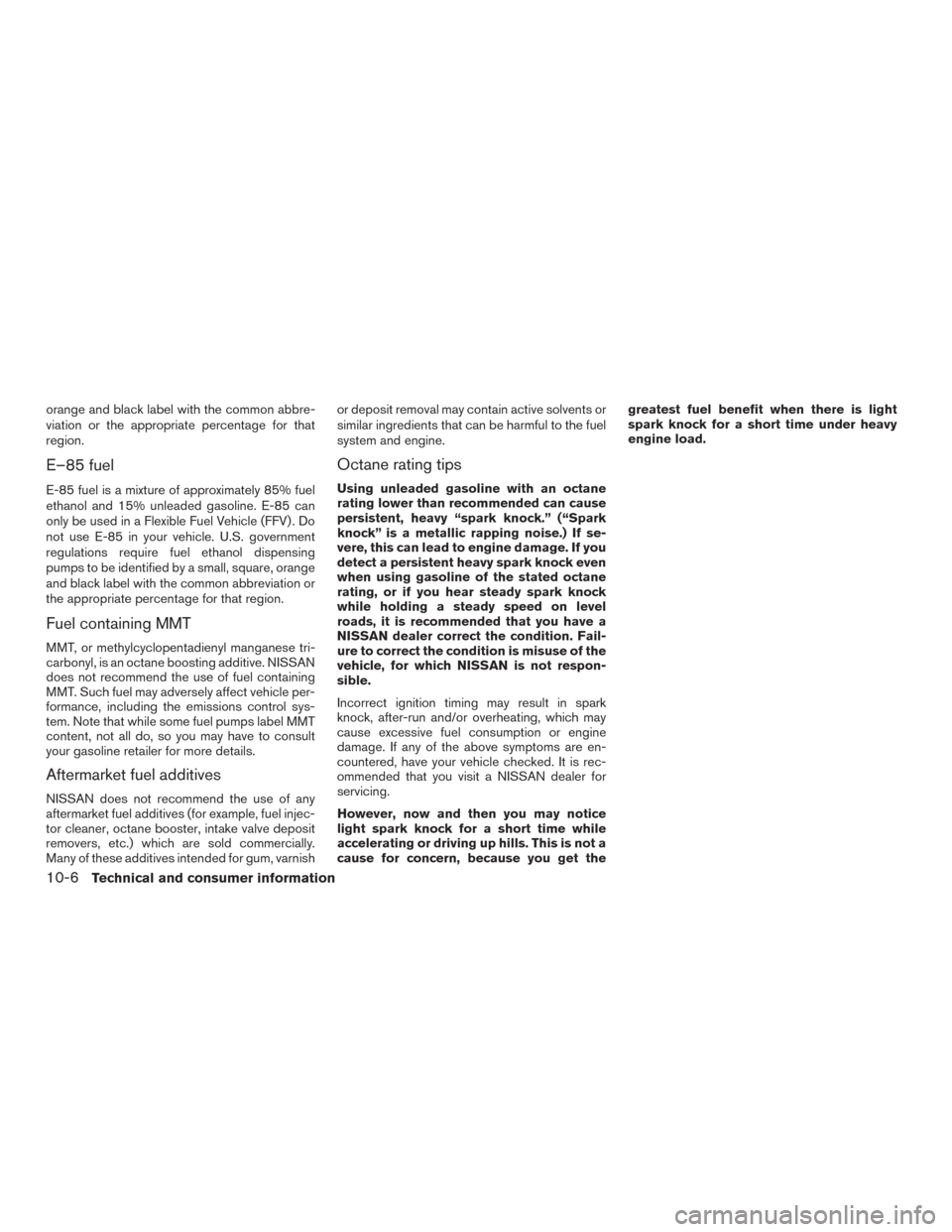
orange and black label with the common abbre-
viation or the appropriate percentage for that
region.
E–85 fuel
E-85 fuel is a mixture of approximately 85% fuel
ethanol and 15% unleaded gasoline. E-85 can
only be used in a Flexible Fuel Vehicle (FFV) . Do
not use E-85 in your vehicle. U.S. government
regulations require fuel ethanol dispensing
pumps to be identified by a small, square, orange
and black label with the common abbreviation or
the appropriate percentage for that region.
Fuel containing MMT
MMT, or methylcyclopentadienyl manganese tri-
carbonyl, is an octane boosting additive. NISSAN
does not recommend the use of fuel containing
MMT. Such fuel may adversely affect vehicle per-
formance, including the emissions control sys-
tem. Note that while some fuel pumps label MMT
content, not all do, so you may have to consult
your gasoline retailer for more details.
Aftermarket fuel additives
NISSAN does not recommend the use of any
aftermarket fuel additives (for example, fuel injec-
tor cleaner, octane booster, intake valve deposit
removers, etc.) which are sold commercially.
Many of these additives intended for gum, varnishor deposit removal may contain active solvents or
similar ingredients that can be harmful to the fuel
system and engine.
Octane rating tips
Using unleaded gasoline with an octane
rating lower than recommended can cause
persistent, heavy “spark knock.” (“Spark
knock” is a metallic rapping noise.) If se-
vere, this can lead to engine damage. If you
detect a persistent heavy spark knock even
when using gasoline of the stated octane
rating, or if you hear steady spark knock
while holding a steady speed on level
roads, it is recommended that you have a
NISSAN dealer correct the condition. Fail-
ure to correct the condition is misuse of the
vehicle, for which NISSAN is not respon-
sible.
Incorrect ignition timing may result in spark
knock, after-run and/or overheating, which may
cause excessive fuel consumption or engine
damage. If any of the above symptoms are en-
countered, have your vehicle checked. It is rec-
ommended that you visit a NISSAN dealer for
servicing.
However, now and then you may notice
light spark knock for a short time while
accelerating or driving up hills. This is not a
cause for concern, because you get thegreatest fuel benefit when there is light
spark knock for a short time under heavy
engine load.
10-6Technical and consumer information
Page 550 of 671
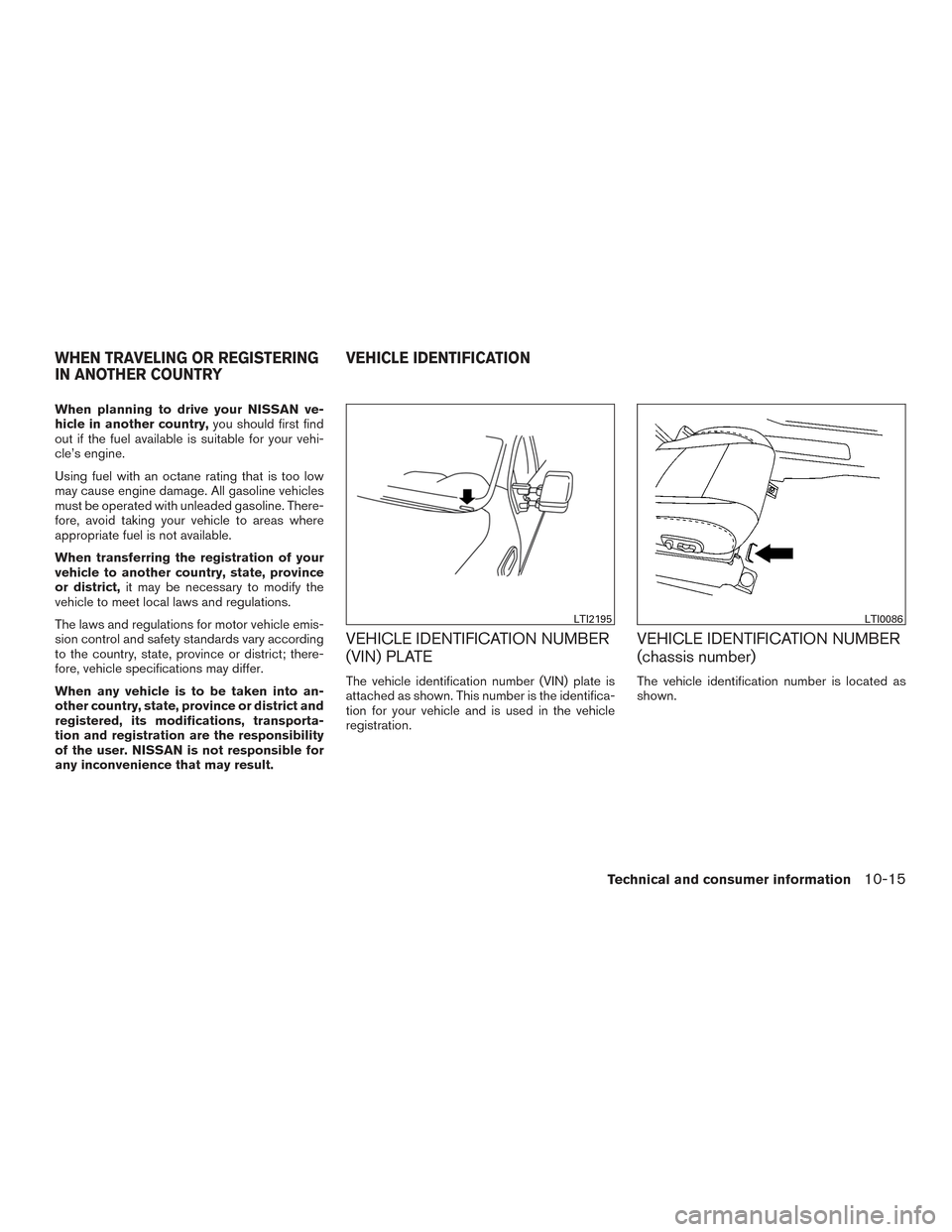
When planning to drive your NISSAN ve-
hicle in another country,you should first find
out if the fuel available is suitable for your vehi-
cle’s engine.
Using fuel with an octane rating that is too low
may cause engine damage. All gasoline vehicles
must be operated with unleaded gasoline. There-
fore, avoid taking your vehicle to areas where
appropriate fuel is not available.
When transferring the registration of your
vehicle to another country, state, province
or district, it may be necessary to modify the
vehicle to meet local laws and regulations.
The laws and regulations for motor vehicle emis-
sion control and safety standards vary according
to the country, state, province or district; there-
fore, vehicle specifications may differ.
When any vehicle is to be taken into an-
other country, state, province or district and
registered, its modifications, transporta-
tion and registration are the responsibility
of the user. NISSAN is not responsible for
any inconvenience that may result.
VEHICLE IDENTIFICATION NUMBER
(VIN) PLATE
The vehicle identification number (VIN) plate is
attached as shown. This number is the identifica-
tion for your vehicle and is used in the vehicle
registration.
VEHICLE IDENTIFICATION NUMBER
(chassis number)
The vehicle identification number is located as
shown.
LTI2195LTI0086
WHEN TRAVELING OR REGISTERING
IN ANOTHER COUNTRY VEHICLE IDENTIFICATION
Technical and consumer information10-15
Page 600 of 671
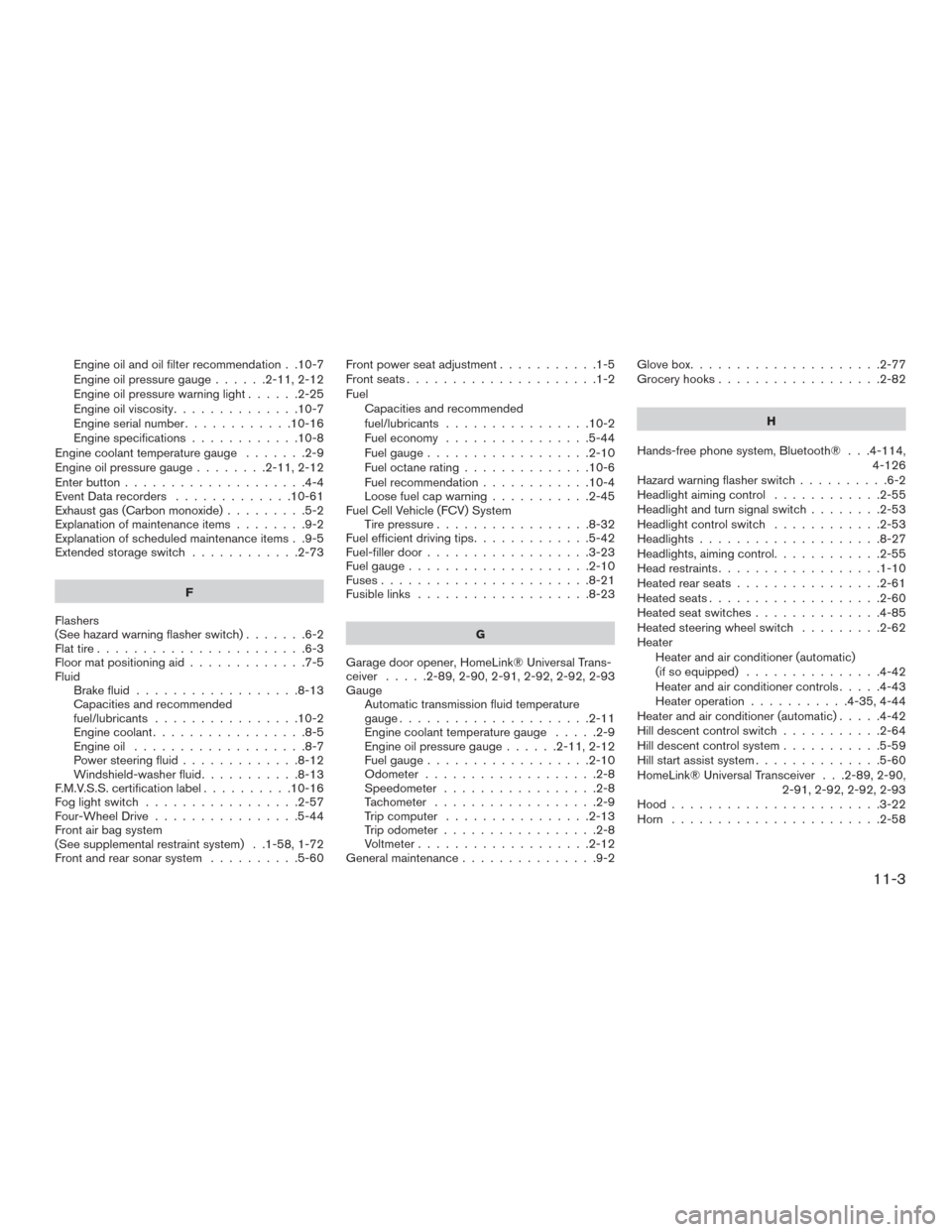
Engine oil and oil filter recommendation . .10-7
Engine oil pressure gauge......2-11,2-12
Engine oil pressure warning light ......2-25
Engine oil viscosity ..............10-7
Engine serial number ............10-16
Engine specifications ............10-8
Engine coolant temperature gauge .......2-9
Engineoilpressuregauge........2-11,2-12
Enterbutton....................4-4
Event Data recorders .............10-61
Exhaust gas (Carbon monoxide) .........5-2
Explanation of maintenance items ........9-2
Explanation of scheduled maintenance items . .9-5
Extendedstorageswitch ............2-73
F
Flashers
(See hazard warning flasher switch) .......6-2
Flat tire .......................6-3
Floor mat positioning aid .............7-5
Fluid Brake fluid ..................8-13
Capacities and recommended
fuel/lubricants ................10-2
Engine coolant .................8-5
Engine oil ...................8-7
Power steering fluid .............8-12
Windshield-washerfluid...........8-13
F.M.V.S.S. certification label ..........10-16
Foglightswitch .................2-57
Four-Wheel Drive ................5-44
Front air bag system
(See supplemental restraint system) . .1-58, 1-72
Front and rear sonar system ..........5-60Front power seat adjustment
...........1-5
Frontseats.....................1-2
Fuel Capacities and recommended
fuel/lubricants ................10-2
Fuel economy ................5-44
Fuel gauge ..................2-10
Fuel octane rating ..............10-6
Fuel recommendation ............10-4
Loose fuel cap warning ...........2-45
Fuel Cell Vehicle (FCV) System Tirepressure.................8-32
Fuel efficient driving tips .............5-42
Fuel-filler door ..................3-23
Fuelgauge....................2-10
Fuses.......................8-21
Fusiblelinks ...................8-23
G
Garage door opener, HomeLink® Universal Trans-
ceiver .....2-89,2-90,2-91,2-92,2-92,2-93
Gauge Automatic transmission fluid temperature
gauge.....................2-11
Engine coolant temperature gauge .....2-9
Engine oil pressure gauge ......2-11,2-12
Fuel gauge ..................2-10
Odometer ...................2-8
Speedometer .................2-8
Tachometer ..................2-9
Trip computer ................2-13
Trip odometer .................2-8
Voltmeter...................2-12
General maintenance ...............9-2 Glovebox.....................2-77
Groceryhooks..................2-82
H
Hands-free phone system, Bluetooth® . . .4-114, 4-126
Hazard warning flasher switch ..........6-2
Headlightaimingcontrol ............2-55
Headlightandturnsignalswitch........2-53
Headlightcontrolswitch ............2-53
Headlights....................8-27
Headlights, aiming control ............2-55
Head restraints ..................1-10
Heated
rear seats ................2-61
Heated seats ...................2-60
Heated seat switches ..............4-85
Heated steering wheel switch .........2-62
Heater Heater and air conditioner (automatic)
(if so equipped) ...............4-42
Heater and air conditioner controls .....4-43
Heater operation ...........4-35,4-44
Heater and air conditioner (automatic) .....4-42
Hill descent control switch ...........2-64
Hill descent control system ...........5-59
Hill start assist system ..............5-60
HomeLink® Universal Transceiver . . .2-89, 2-90, 2-91, 2-92, 2-92, 2-93
Hood.......................3-22
Horn .......................2-58
11-3
Page 602 of 671
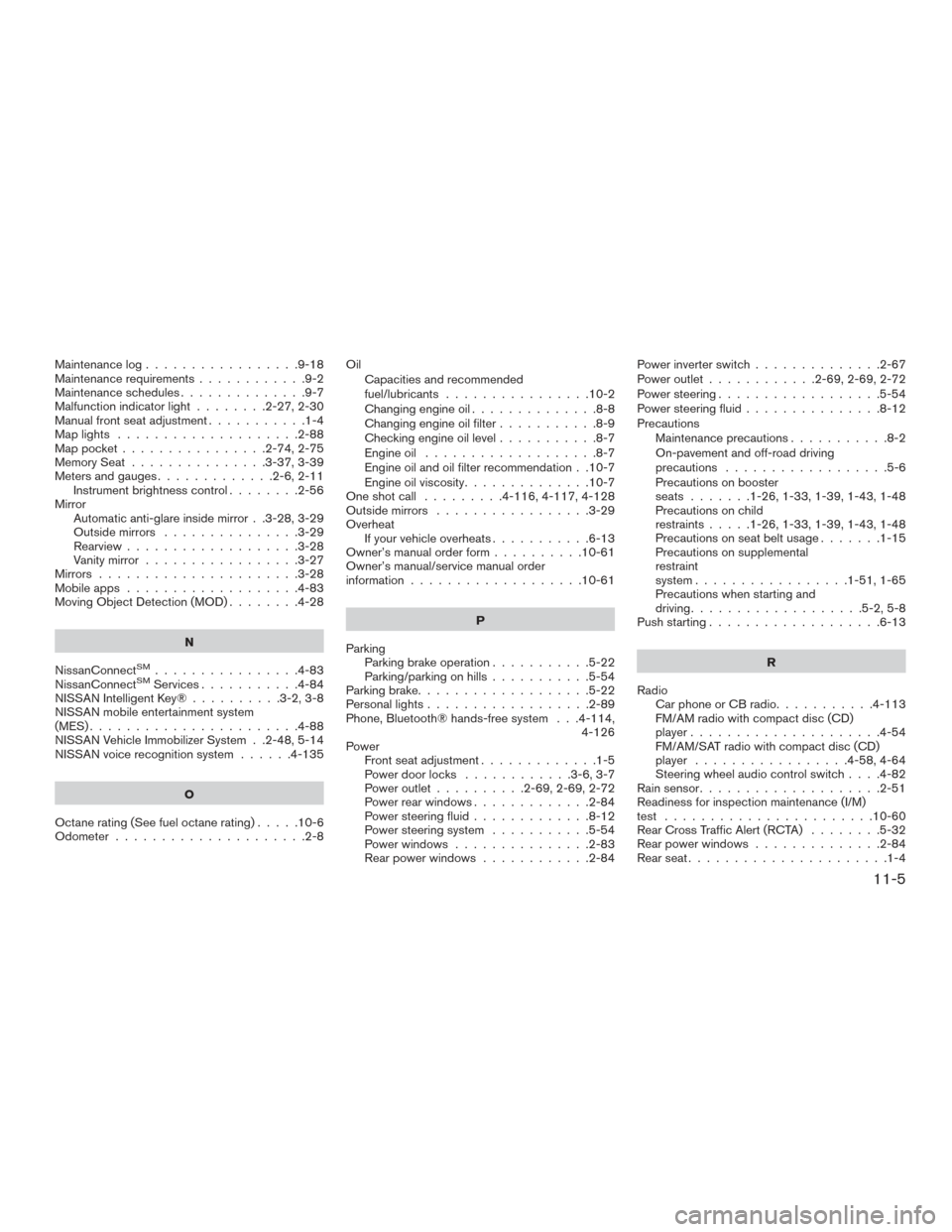
Maintenance log.................9-18
Maintenance requirements ............9-2
Maintenance schedules ..............9-7
Malfunction indicator light ........2-27,2-30
Manual front seat adjustment ...........1-4
Maplights ....................2-88
Map pocket ................2-74,2-75
Memory Seat ...............3-37,3-39
Meters and gauges .............2-6,2-11
Instrument brightness control ........2-56
Mirror Automatic anti-glare inside mirror . .3-28, 3-29
Outside mirrors ...............3-29
Rearview ...................3-28
Vanity mirror .................3-27
Mirrors ......................3-28
Mobileapps ...................4-83
Moving Object Detection (MOD) ........4-28
N
NissanConnect
SM................4-83
NissanConnectSMServices...........4-84
NISSAN Intelligent Key® ..........3-2,3-8
NISSAN mobile entertainment system
(MES) .......................4-88
NISSAN Vehicle Immobilizer System . .2-48, 5-14
NISSAN voice recognition system ......4-135
O
Octanerating(Seefueloctanerating).....10-6
Odometer .....................2-8 Oil
Capacities and recommended
fuel/lubricants ................10-2
Changingengineoil..............8-8
Changing engine oil filter ...........8-9
Checking engine oil level ...........8-7
Engine oil ...................8-7
Engine oil and oil filter recommendation . .10-7
Engine oil viscosity ..............10-7
Oneshotcall .........4- 116, 4-117, 4-128
Outside mirrors .................3-29
Overheat If your vehicle overheats ...........6-13
Owner’s manual order form ..........10-61
Owner’s manual/service manual order
information ...................10-61
P
Parking Parking brake operation ...........5-22
Parking/parking on hills ...........5-54
Parking brake ...................5-22
Personallights..................2-89
Phone, Bluetooth® hands-free system . . .4-114, 4-126
Power Front seat adjustment .............1-5
Power door locks ............3-6,3-7
Power outlet ..........2-69,2-69,2-72
Power rear windows .............2-84
Power steering fluid .............8-12
Power steering system ...........5-54
Power windows ...............2-83
Rear power windows ............2-84 Power inverter switch
..............2-67
Power outlet ............2-69,2-69,2-72
Power steering ..................5-54
Power steering fluid ...............8-12
Precautions Maintenance precautions ...........8-2
On-pavement and off-road driving
precautions ..................5-6
Precautions on booster
seats .......1-26,1-33,1-39,1-43,1-48
Precautions on child
restraints .....1-26,1-33,1-39,1-43,1-48
Precautions on seat belt usage .......1-15
Precautions on supplemental
restraint
system .................1-51,1-65
Precautions when starting and
driving ...................5-2,5-8
Push starting ...................6-13
R
Radio CarphoneorCBradio...........4-113
FM/AM radio with compact disc (CD)
player .....................4-54
FM/AM/SAT radio with compact disc (CD)
player .................4-58,4-64
Steering wheel audio control switch . . . .4-82
Rainsensor....................2-51
Readiness for inspection maintenance (I/M)
test .......................10-60
Rear Cross Traffic Alert (RCTA) ........5-32
Rear power windows ..............2-84
Rearseat......................1-4
11-5
Page 606 of 671
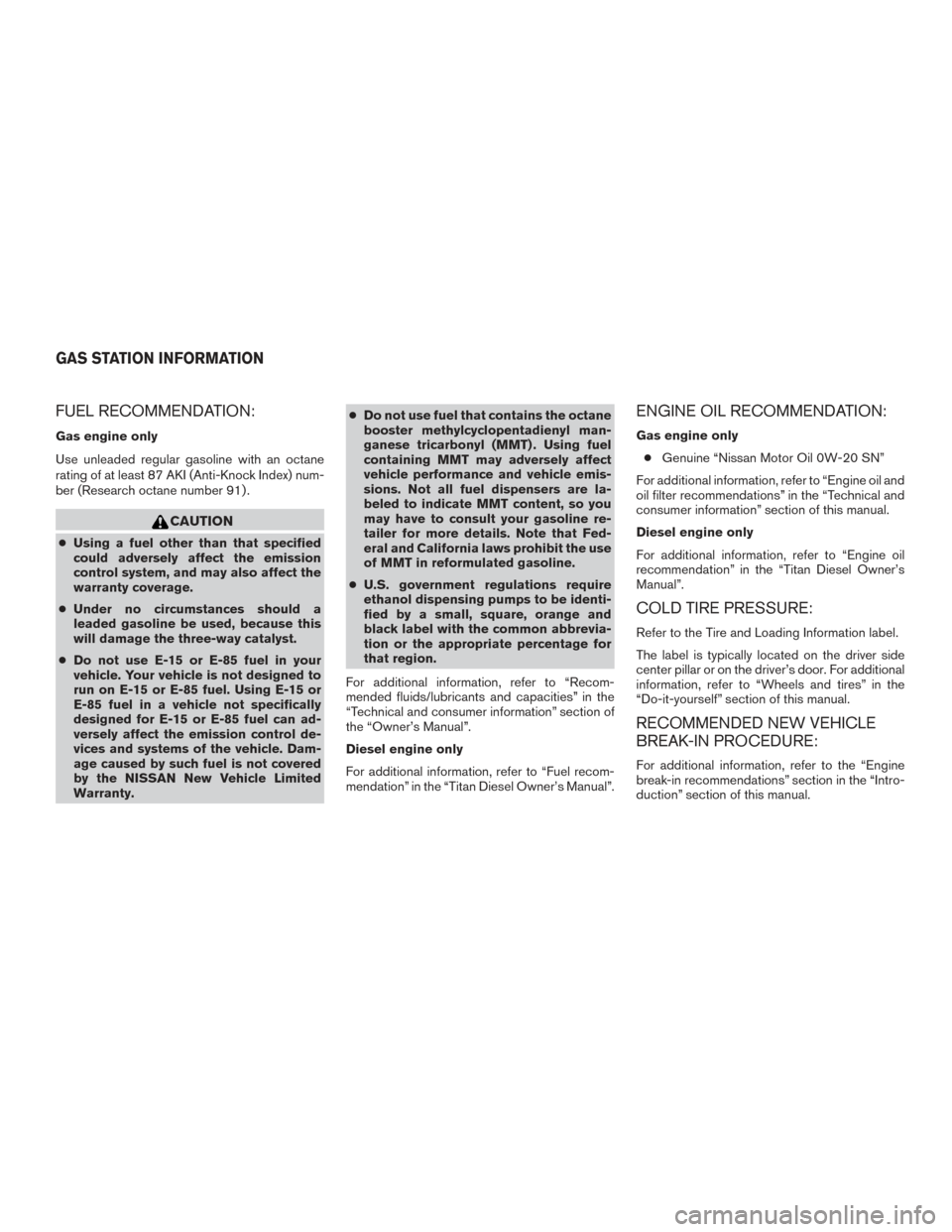
FUEL RECOMMENDATION:
Gas engine only
Use unleaded regular gasoline with an octane
rating of at least 87 AKI (Anti-Knock Index) num-
ber (Research octane number 91) .
CAUTION
●Using a fuel other than that specified
could adversely affect the emission
control system, and may also affect the
warranty coverage.
● Under no circumstances should a
leaded gasoline be used, because this
will damage the three-way catalyst.
● Do not use E-15 or E-85 fuel in your
vehicle. Your vehicle is not designed to
run on E-15 or E-85 fuel. Using E-15 or
E-85 fuel in a vehicle not specifically
designed for E-15 or E-85 fuel can ad-
versely affect the emission control de-
vices and systems of the vehicle. Dam-
age caused by such fuel is not covered
by the NISSAN New Vehicle Limited
Warranty. ●
Do not use fuel that contains the octane
booster methylcyclopentadienyl man-
ganese tricarbonyl (MMT) . Using fuel
containing MMT may adversely affect
vehicle performance and vehicle emis-
sions. Not all fuel dispensers are la-
beled to indicate MMT content, so you
may have to consult your gasoline re-
tailer for more details. Note that Fed-
eral and California laws prohibit the use
of MMT in reformulated gasoline.
● U.S. government regulations require
ethanol dispensing pumps to be identi-
fied by a small, square, orange and
black label with the common abbrevia-
tion or the appropriate percentage for
that region.
For additional information, refer to “Recom-
mended fluids/lubricants and capacities” in the
“Technical and consumer information” section of
the “Owner’s Manual”.
Diesel engine only
For additional information, refer to “Fuel recom-
mendation” in the “Titan Diesel Owner’s Manual”.
ENGINE OIL RECOMMENDATION:
Gas engine only ● Genuine “Nissan Motor Oil 0W-20 SN”
For additional information, refer to “Engine oil and
oil filter recommendations” in the “Technical and
consumer information” section of this manual.
Diesel engine only
For additional information, refer to “Engine oil
recommendation” in the “Titan Diesel Owner’s
Manual”.
COLD TIRE PRESSURE:
Refer to the Tire and Loading Information label.
The label is typically located on the driver side
center pillar or on the driver’s door. For additional
information, refer to “Wheels and tires” in the
“Do-it-yourself” section of this manual.
RECOMMENDED NEW VEHICLE
BREAK-IN PROCEDURE:
For additional information, refer to the “Engine
break-in recommendations” section in the “Intro-
duction” section of this manual.
GAS STATION INFORMATION